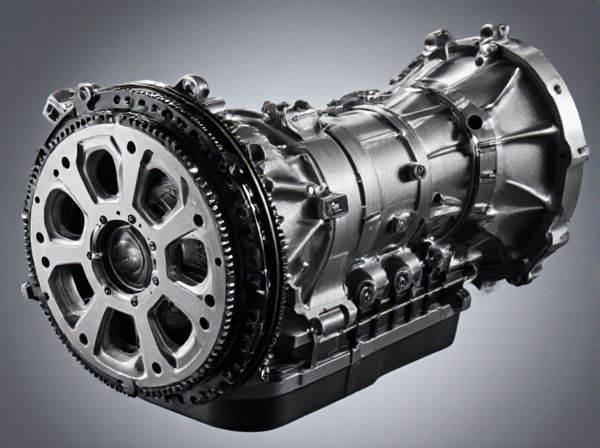
Photo illustration: Dual-clutch vs Single-clutch
Dual-clutch transmissions offer faster and smoother gear changes compared to single-clutch systems, enhancing driving performance and fuel efficiency. Single-clutch transmissions are generally simpler and more cost-effective but may result in slower shifts and less refined handling. Your choice depends on whether you prioritize driving dynamics or budget-friendly maintenance.
Table of Comparison
| Feature | Dual-Clutch Transmission (DCT) | Single-Clutch Transmission |
|---|---|---|
| Shift Speed | Faster, seamless gear changes | Slower, noticeable shift lag |
| Fuel Efficiency | Improved due to efficient power transfer | Moderate, less efficient |
| Complexity | Higher, requires advanced electronics | Lower, simpler design |
| Cost | Higher price and maintenance | Lower price and maintenance |
| Driving Experience | Smoother, sportier performance | Rougher shifts, less refined |
| Reliability | Good but sensitive to maintenance | Generally robust and durable |
Introduction to Clutch Technologies
Dual-clutch technology utilizes two separate clutches for odd and even gear sets, enabling faster and smoother gear shifts compared to single-clutch systems that rely on one clutch engaging and disengaging. Single-clutch transmissions, often referred to as manual or traditional automatic clutches, provide simpler mechanics but may experience more shift lag and less fuel efficiency. Modern dual-clutch systems enhance driving performance and fuel economy by reducing power interruption during gear changes, making them popular in high-performance and efficiency-focused vehicles.
What is a Single-Clutch System?
A single-clutch system uses one clutch disc to connect and disconnect the engine from the transmission, enabling gear changes in manual and automated manual transmissions. This system typically offers lower cost and simpler mechanical design than dual-clutch systems but may result in slower shift speeds and more noticeable torque interruption during gear changes. Single-clutch transmissions are commonly found in entry-level vehicles and motorcycles where efficiency and affordability are prioritized over performance.
What is a Dual-Clutch System?
A dual-clutch system features two separate clutches for odd and even gear sets, enabling faster and smoother gear shifts compared to single-clutch transmissions. This technology improves acceleration and fuel efficiency by preselecting the next gear while the current one is engaged. Dual-clutch systems are commonly used in performance and modern passenger vehicles for enhanced driving dynamics and response.
Comparative Transmission Performance
Dual-clutch transmissions deliver faster and smoother gear shifts compared to single-clutch systems, enhancing acceleration and fuel efficiency. Single-clutch transmissions typically exhibit longer shift times and increased torque interruption, resulting in less responsive driving dynamics. Performance metrics show dual-clutch systems reduce shift lag by up to 50%, optimizing power delivery for sports and high-performance vehicles.
Efficiency and Fuel Economy
Dual-clutch transmissions (DCT) deliver higher efficiency and better fuel economy by enabling faster and smoother gear shifts with minimal power loss compared to single-clutch systems. Single-clutch automated manuals often experience slower engagement and increased drag, resulting in reduced fuel efficiency under similar driving conditions. Vehicles equipped with dual-clutch technology generally achieve improved mileage by optimizing gear change timing and maintaining engine performance more effectively.
Driving Experience and Comfort
Dual-clutch transmissions (DCT) provide smoother and faster gear shifts, enhancing driving experience by reducing lag and improving acceleration response. Single-clutch systems often deliver a less refined shift feel with noticeable interruptions during gear changes, which can affect ride comfort. The seamless operation of DCTs ensures better comfort on varied driving conditions, minimizing vibrations and jerks typical of single-clutch setups.
Maintenance and Reliability
Dual-clutch transmissions generally require more specialized maintenance due to their complex design, including precise clutch pack adjustments and frequent software updates. Single-clutch systems, while simpler and more cost-effective to service, tend to have more frequent wear on the single clutch plate, leading to potentially higher replacement costs over time. Reliability often favors single-clutch setups in heavy-duty applications, whereas dual-clutch transmissions excel in performance but may present higher long-term maintenance expenses.
Application in Vehicles and Use Cases
Dual-clutch transmissions (DCT) provide faster gear shifts and improved fuel efficiency, making them ideal for performance cars and sporty vehicles requiring quick acceleration and seamless power delivery. Single-clutch automated manual transmissions (AMT) are typically favored in economy or compact cars due to their simpler design, lower cost, and ease of maintenance, offering smooth gear changes for daily urban driving. DCTs excel in high-performance contexts where rapid shifting is critical, while single-clutch systems cater to budget-conscious drivers prioritizing reliability and cost-effectiveness.
Cost and Value Considerations
Dual-clutch transmissions generally have higher initial costs due to their complex design and advanced technology compared to single-clutch systems, which are simpler and more affordable. Maintenance and repair expenses for dual-clutch units can be significant, but their quicker shift times and improved fuel efficiency often provide better long-term value for performance-oriented drivers. Single-clutch transmissions offer lower upfront costs and simpler maintenance, making them a cost-effective choice for budget-conscious consumers prioritizing reliability over high performance.
Which System Should You Choose?
Dual-clutch transmissions (DCT) offer faster and smoother gear shifts, enhancing performance and fuel efficiency, making them ideal for sporty and high-performance vehicles. Single-clutch systems, or traditional manual gearboxes, provide simpler mechanics, lower maintenance costs, and greater driver control, preferred by enthusiasts and budget-conscious drivers. Choose a dual-clutch system for precision and speed, while a single-clutch setup suits those valuing reliability and tactile driving experience.
 caratoz.com
caratoz.com